 |
It's tough to admit in these politically-correct times of ours, but one of the most influential, enduring and celebrated of all classical masterworks, the Symphonie Fantastique of Hector Berlioz, was meant to depict a drug trip. but one of the most influential, enduring and celebrated of all classical masterworks, the Symphonie Fantastique of Hector Berlioz, was meant to depict a drug trip.
According to the composer's own detailed program, his symphony aimed to describe the tortured dreams of a sensitive artist in lovesick despair who takes an overdose of opium and becomes haunted by visions of an unattainable woman. In the course of five movements, he first tempers his depression, volcanic love and jealous rages through religious consolation; encounters her at a festive ball; seeks solace wandering in the countryside only to have her disrupt his idyll; is condemned and guillotined for murdering her; and finally sees his funeral plummet into a witches' desecration of the Sabbath which she leads to a climactic orgy. his symphony aimed to describe the tortured dreams of a sensitive artist in lovesick despair who takes an overdose of opium and becomes haunted by visions of an unattainable woman. In the course of five movements, he first tempers his depression, volcanic love and jealous rages through religious consolation; encounters her at a festive ball; seeks solace wandering in the countryside only to have her disrupt his idyll; is condemned and guillotined for murdering her; and finally sees his funeral plummet into a witches' desecration of the Sabbath which she leads to a climactic orgy.
Did Berlioz actually compose his Fantastique “under the influence?” That's unclear, but the tale of the work's creation and its autobiographical roots is just as bizarre as the story it portrays. 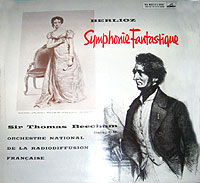 In September 1827 the impressionable 23 year old Berlioz attended a performance by a visiting English Shakespeare troupe at the Odeon Theatre in Paris and was overwhelmed not only by his first exposure to Hamlet but by Harriet Smithson, the Irish actress who played Ophelia. Deeply smitten, he desperately tried to attract her attention, but the superstar spurned the unknown composer's attempts, even declining to attend two concerts he arranged for her. When she finally returned home without meeting him, Berlioz sublimated his frustration into the Symphonie Fantastique, his first major work. (The final movement was impelled by rumors that Smithson was having an affair with her manager; as revenge, Berlioz symbolically cast her into hell as a whore.) In September 1827 the impressionable 23 year old Berlioz attended a performance by a visiting English Shakespeare troupe at the Odeon Theatre in Paris and was overwhelmed not only by his first exposure to Hamlet but by Harriet Smithson, the Irish actress who played Ophelia. Deeply smitten, he desperately tried to attract her attention, but the superstar spurned the unknown composer's attempts, even declining to attend two concerts he arranged for her. When she finally returned home without meeting him, Berlioz sublimated his frustration into the Symphonie Fantastique, his first major work. (The final movement was impelled by rumors that Smithson was having an affair with her manager; as revenge, Berlioz symbolically cast her into hell as a whore.)
The completion of the story is odder still. Berlioz won a prestigious prize and spent two years in Rome, where he wrote the even more overtly autobiographical L�lio, a sequel of music (largely derived from previous works) linked by narration depicting an artist's return to life after the nightmares of the Symphonie.  Upon returning to Paris, Berlioz rented new rooms only to discover that the previous occupant had been none other than Smithson! Overwhelmed by this coincidence, Berlioz arranged through an intermediary for her to attend a concert featuring the Symphonie and his new L�lio. Upon hearing the L�lio narrator urge how his heart yearned for Ophelia, Smithson realized that it was she who had inspired this fervent outpouring of creativity. They met and ultimately married, but didn't live happily ever after – Smithson couldn't possibly live up to the Shakespearean goddess Berlioz had idolized. (Yet, a decade later, his passion for Shakespeare and his idealized feelings for the complexities and redemptive powers of love returned in full force to flower into his mammoth and magnificent oratorio Romeo and Juliet.) Upon returning to Paris, Berlioz rented new rooms only to discover that the previous occupant had been none other than Smithson! Overwhelmed by this coincidence, Berlioz arranged through an intermediary for her to attend a concert featuring the Symphonie and his new L�lio. Upon hearing the L�lio narrator urge how his heart yearned for Ophelia, Smithson realized that it was she who had inspired this fervent outpouring of creativity. They met and ultimately married, but didn't live happily ever after – Smithson couldn't possibly live up to the Shakespearean goddess Berlioz had idolized. (Yet, a decade later, his passion for Shakespeare and his idealized feelings for the complexities and redemptive powers of love returned in full force to flower into his mammoth and magnificent oratorio Romeo and Juliet.)
But back to the music. From the very outset, the Symphonie Fantastique, whether reviled or lauded, was recognized as something powerful and altogether new. Among fellow composers, the gentle Felix Mendelssohn was appalled at its excesses and dismissed it as “utterly loathsome,” while the free-thinking Franz Liszt was intrigued and hailed it as genius. 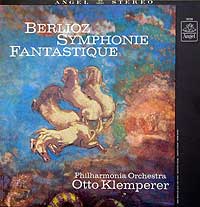 In a remarkably astute extended review, Robert Schumann reconciled these views by detailing both its indebtedness to and departures from conventional form. In a remarkably astute extended review, Robert Schumann reconciled these views by detailing both its indebtedness to and departures from conventional form.
In retrospect, we acknowledge the Symphonie Fantastique as the first full musical outpouring of Romanticism, in which impulsive personal inspiration bursts through the constraints of formality. Berlioz was the ideal vehicle for this culmination, as he was the first famous composer who didn't play an instrument and thus could view music abstractly; as he put it in his extensive M�moires, he was freed from the “tyranny of fingers” and “ordinary sonorities” to “compose freely and in silence.” His freedom was manifested in both the Symphonie's novel structure and sound.
The entire work is unified by an “id�e fixe,” a recurrent and strikingly complex theme symbolizing his beloved – 40 measures long, jagged and deeply chromatic, it keeps yearning upward only to fall back in despair. While Beethoven, for one, had recalled prior ideas in the finales of his fifth and ninth symphonies, Berlioz's innovation of using the same theme throughout paved the way for Wagner's leitmotifs that would soon transform opera.  Similarly, while Haydn had invoked militia and Beethoven had summoned scenes of nature in their symphonies, never before had a concert-hall work tried to depict a specific story, and Berlioz's Symphonie thus served as a herald of the programmatic tone-poems which came to dominate the late 19th century. Similarly, while Haydn had invoked militia and Beethoven had summoned scenes of nature in their symphonies, never before had a concert-hall work tried to depict a specific story, and Berlioz's Symphonie thus served as a herald of the programmatic tone-poems which came to dominate the late 19th century.
The instrumentation itself was novel – harps, cornets (used only in dance-halls at the time), ophicleides (a deep, rasping forerunner of the tuba) and a battery of percussion. Berlioz also specified numerous innovative effects – an off-stage oboe to imply distance, violins played with the wood of their bows to invoke terror, and a strikingly modern minimalist passage of chords for four solo tympani to suggest echoing thunder.
Berlioz took great care to ensure that his aural conception would be followed in performance. Thus, beyond exhaustive markings to specify dynamics, accents and phrasing, his score is replete with detailed instructions, ranging from a suggestion how to rehearse a tricky rhythmic passage to a defense of a “wrong” note.
The gongs that prominently toll the Dies Irae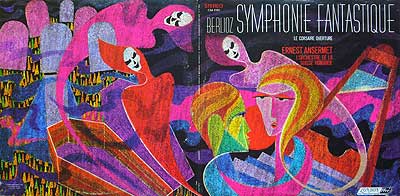 dirge (c-c-G) throughout much of the finale present a special challenge. Berlioz indicated in the score that they should sound in any of three octaves, but specified in his instructions that if deep bells couldn't be found, then it would be better to just use a piano. Nearly every record uses the sharp fire-bell type commonly found in the orchestral arsenal. Ernest Ansermet, dissatisfied with all the available ones he heard, insisted that a new set be forged just for his 1967 recording with the Orchestre de la Suisse Romande (now on London 433 713). In a rehearsal LP accompanying the original issue (on London CSA 2101), the musicians laugh out loud upon first hearing the sour sound, but, as Ansermet admonishes, these are not xylophones with pure tones but real bells with rich, complex harmonics that produce a darkly dissonant and utterly chilling impact. His and only a few other recordings (notably Walter/Vienna and Mitropoulos/New York) benefit from this odd but magnificent effect. dirge (c-c-G) throughout much of the finale present a special challenge. Berlioz indicated in the score that they should sound in any of three octaves, but specified in his instructions that if deep bells couldn't be found, then it would be better to just use a piano. Nearly every record uses the sharp fire-bell type commonly found in the orchestral arsenal. Ernest Ansermet, dissatisfied with all the available ones he heard, insisted that a new set be forged just for his 1967 recording with the Orchestre de la Suisse Romande (now on London 433 713). In a rehearsal LP accompanying the original issue (on London CSA 2101), the musicians laugh out loud upon first hearing the sour sound, but, as Ansermet admonishes, these are not xylophones with pure tones but real bells with rich, complex harmonics that produce a darkly dissonant and utterly chilling impact. His and only a few other recordings (notably Walter/Vienna and Mitropoulos/New York) benefit from this odd but magnificent effect.
Of all the conductors to have tackled Berlioz on record, Pierre Monteux had the closest ties to the composer. Monteux's first serious job (which lasted 17 years) was as first violist and then assistant conductor of the Colonne Orchestra. 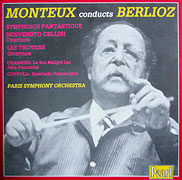 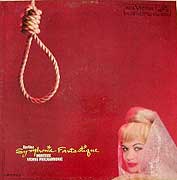 Its founder, Edouard Colonne, had known Berlioz and had absorbed the composer's interpretive outlook first-hand. As the basis for his 1931 recording Monteux used a score annotated with Colonne's directions. (The precious score was lost when Nazis looted Monteux's home.) Despite four remakes, Monteux insisted that this first outing with his Paris Symphony Orchestra (on Pearl 9012 or Music & Arts 732) was his finest. Indeed, it's remarkably clean and transparent, refined but with a marvelous lilt and spirit. The only audible compromise was to telescope the dynamic range to accommodate the technical limitations of the early electrical equipment by avoiding overload or slipping into the noise. Of his subsequent recordings, the San Francisco Symphony (1945 on BMG 61894) presents a slightly bolder and more sharply accented take on the same basic interpretation while the smooth playing of the Vienna Philharmonic (1959, RCA LP) strips away much of the character. Monteux's first Fantastique remains the closest link we will ever have to its creator. Its founder, Edouard Colonne, had known Berlioz and had absorbed the composer's interpretive outlook first-hand. As the basis for his 1931 recording Monteux used a score annotated with Colonne's directions. (The precious score was lost when Nazis looted Monteux's home.) Despite four remakes, Monteux insisted that this first outing with his Paris Symphony Orchestra (on Pearl 9012 or Music & Arts 732) was his finest. Indeed, it's remarkably clean and transparent, refined but with a marvelous lilt and spirit. The only audible compromise was to telescope the dynamic range to accommodate the technical limitations of the early electrical equipment by avoiding overload or slipping into the noise. Of his subsequent recordings, the San Francisco Symphony (1945 on BMG 61894) presents a slightly bolder and more sharply accented take on the same basic interpretation while the smooth playing of the Vienna Philharmonic (1959, RCA LP) strips away much of the character. Monteux's first Fantastique remains the closest link we will ever have to its creator.
An equally strong pedigree can be claimed by a 1928 performance 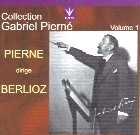 (actually of only the second, fourth and final movements) (Lys 287) - it features the Colonne Orchestra itself, conducted by Gabriel Piern�, the founder's successor. The playing has a lovely, causal “French” feel, often mistaken for carelessness nowadays by ears accustomed to our modern style of precision. (actually of only the second, fourth and final movements) (Lys 287) - it features the Colonne Orchestra itself, conducted by Gabriel Piern�, the founder's successor. The playing has a lovely, causal “French” feel, often mistaken for carelessness nowadays by ears accustomed to our modern style of precision.
A different but related type of validity arises in two original instrument versions,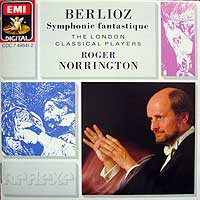 which attempt to replicate the sonority Berlioz intended by using the instruments (gut strings, small harps, stopped rather than keyed brass, genuine ophicleides), techniques (minimal vibrato, steady bowing, moderate tempos), and tuning (a = 435 Hz) of his time. Roger Norrington and the London Classical Players (EMI 49541) were the first to apply this approach and still startle with their lean and classic sound. The musicians are even arrayed according to Berlioz's seating plan, which provides a natural “stereo” effect by dividing the violins, harps and tympani to the sides of the stage. Yet, there are only 82 players, whereas Berlioz wanted several hundred and settled for “only” 130 at the premi�re. which attempt to replicate the sonority Berlioz intended by using the instruments (gut strings, small harps, stopped rather than keyed brass, genuine ophicleides), techniques (minimal vibrato, steady bowing, moderate tempos), and tuning (a = 435 Hz) of his time. Roger Norrington and the London Classical Players (EMI 49541) were the first to apply this approach and still startle with their lean and classic sound. The musicians are even arrayed according to Berlioz's seating plan, which provides a natural “stereo” effect by dividing the violins, harps and tympani to the sides of the stage. Yet, there are only 82 players, whereas Berlioz wanted several hundred and settled for “only” 130 at the premi�re.
John Eliot Gardiner and the Orchestre Revolutionnaire et Romantique (Philips 434 402) went a step further -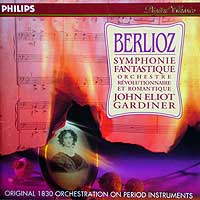 their 1991 period instrument recording was made in the very auditorium where Berlioz attended concerts, formed his sense of orchestral tone and staged his own first performances! Thus, their tight, focused sonic clarity is achieved not by mixing multiple microphones but through the natural ambience of the hall, yielding our most accurate aural reproduction of the sonic image that fueled Berlioz to create his work. Despite the scrupulously authentic sound, Gardiner tweaks the score's prescriptions with considerable latitude in tempo, balance and dynamics. In context, his expressive liberties sound wonderful, breathing spontaneity and life into what otherwise could have been a dry academic exercise in historical restoration. their 1991 period instrument recording was made in the very auditorium where Berlioz attended concerts, formed his sense of orchestral tone and staged his own first performances! Thus, their tight, focused sonic clarity is achieved not by mixing multiple microphones but through the natural ambience of the hall, yielding our most accurate aural reproduction of the sonic image that fueled Berlioz to create his work. Despite the scrupulously authentic sound, Gardiner tweaks the score's prescriptions with considerable latitude in tempo, balance and dynamics. In context, his expressive liberties sound wonderful, breathing spontaneity and life into what otherwise could have been a dry academic exercise in historical restoration.
Berlioz himself reportedly was a physically active conductor yet sought clear and moderate results, letting his music speak largely for itself. (Of course, given the amount of detail in his scores, it's hardly surprising that he saw little need to augment his own directions.) And yet, as Schumann noted in his review, “Form is the vessel of the spirit.” Indeed, notions of “authenticity” seem somewhat misplaced for so personal a work that bursts with the spirit of Romanticism.
The earliest and most extreme recorded example 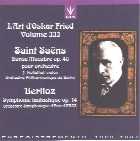 of a distinctive proactive interpretive approach is a 1938 account (Lys 280) in which Oskar Fried jolts the USSR State Symphony with such sudden and wildly impulsive tempo swings (especially in the fourth movement which, after all, is a steady march) that the orchestra can barely follow and the ensemble becomes quite messy. of a distinctive proactive interpretive approach is a 1938 account (Lys 280) in which Oskar Fried jolts the USSR State Symphony with such sudden and wildly impulsive tempo swings (especially in the fourth movement which, after all, is a steady march) that the orchestra can barely follow and the ensemble becomes quite messy. 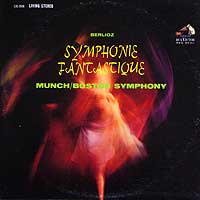 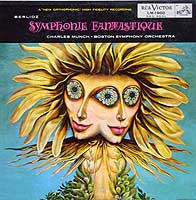 Other fleet and headstrong accounts which invoke the youthful ardor of the composer include those by Charles Munch and the Boston Symphony, both in 1954 (RCA 68444) and a 1962 remake (RCA 68979), in which the final two movements spring to life; Paul Paray and the Detroit Symphony (Mercury 34328), who clock the fastest reading on record (45 minutes) with sensationally ardent, impulsive, breakneck tempos; and Edward von Beinum and the Concertgebouw (Beulah 117), abetted by Decca's wonderfully detailed “ffrr” recording. Other fleet and headstrong accounts which invoke the youthful ardor of the composer include those by Charles Munch and the Boston Symphony, both in 1954 (RCA 68444) and a 1962 remake (RCA 68979), in which the final two movements spring to life; Paul Paray and the Detroit Symphony (Mercury 34328), who clock the fastest reading on record (45 minutes) with sensationally ardent, impulsive, breakneck tempos; and Edward von Beinum and the Concertgebouw (Beulah 117), abetted by Decca's wonderfully detailed “ffrr” recording.
Leonard Bernstein, too,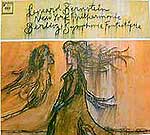 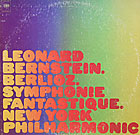 left rich and impassioned accounts. He digs into the music with vibrant enthusiasm in 1963 and 1968, both with the New York Philharmonic (the latter, mislabelled as the 1963 version on Sony SMK 60968 includes his lecture tracing the id�e fixe with musical examples). A 1976 remake with the Orchestre National de France (EMI 69002) achieves a fascinating combination of his edgy excitement with a mellow “French” sonority. left rich and impassioned accounts. He digs into the music with vibrant enthusiasm in 1963 and 1968, both with the New York Philharmonic (the latter, mislabelled as the 1963 version on Sony SMK 60968 includes his lecture tracing the id�e fixe with musical examples). A 1976 remake with the Orchestre National de France (EMI 69002) achieves a fascinating combination of his edgy excitement with a mellow “French” sonority.
The English developed a strong affinity for Berlioz, 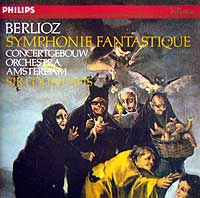 beginning with Sir Charles Hall�, whose still-famous namesake orchestra was begun in 1857 in part to expose his friend's work. The first Brit to record Berlioz was Sir Hamilton Harty; although he never cut the Symphonie, a collection of overtures and excerpts (Pearl 9485) combines textural clarity with inventive impulse. beginning with Sir Charles Hall�, whose still-famous namesake orchestra was begun in 1857 in part to expose his friend's work. The first Brit to record Berlioz was Sir Hamilton Harty; although he never cut the Symphonie, a collection of overtures and excerpts (Pearl 9485) combines textural clarity with inventive impulse.  Sir Thomas Beecham's famed 1959 Fantastique with the French National Radio Orchestra (EMI 64032) is heavily inflected yet full of �lan. But it was Sir Colin Davis who sparked modern interest in the composer through a landmark 1960s cycle of lesser-known Berlioz. His fourth Fantastique (a 2000 London Symphony concert, LSO 0007), while generally adhering to the dynamics and tempos of the score, derives exquisite subtlety from its emotional reserve and superb playing. Sir Thomas Beecham's famed 1959 Fantastique with the French National Radio Orchestra (EMI 64032) is heavily inflected yet full of �lan. But it was Sir Colin Davis who sparked modern interest in the composer through a landmark 1960s cycle of lesser-known Berlioz. His fourth Fantastique (a 2000 London Symphony concert, LSO 0007), while generally adhering to the dynamics and tempos of the score, derives exquisite subtlety from its emotional reserve and superb playing.
Among the less conventional choices, especially fascinating is a 1968 reading by Leopold Stokowski and the New Philharmonia (London 430 137), a conductor famed for his sensitivity to instrumental color. Nothing subtle here - Stoki wallows in the Berlioz effects,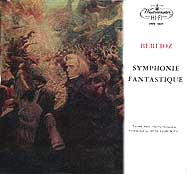 producing a ripe, luscious portrait, in which accompanying figures leap into the spotlight, abetted by exaggerated stereo imaging and, less fortunately, heavy overload distortion. Also attracted by tone coloration rather than expressive content is Pierre Boulez, whose 1967 London Symphony recording (Sony SM3K 64103) producing a ripe, luscious portrait, in which accompanying figures leap into the spotlight, abetted by exaggerated stereo imaging and, less fortunately, heavy overload distortion. Also attracted by tone coloration rather than expressive content is Pierre Boulez, whose 1967 London Symphony recording (Sony SM3K 64103)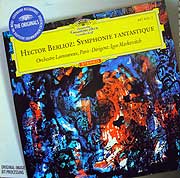 was reviled for being too detached but achieves a harrowing atmosphere through its chillingly precise playing and razor-sharp recording, qualities that are only slightly mellowed his 1997 remake with the Cleveland Orchestra (DG 453432). Rene Leibowitz, also a modernist composer, gives full rein to inner voices and harmonies, although the impact is somewhat blunted by ensemble lapses of the Vienna State Opera Orchestra (Westminster/DG 471 242, 1959). Subtle yet unsettling is the 1961 record by yet a third composer/conductor, Igor Markevitch and the Orchestre Lamoureux (DG 447 406), a remarkable portrayal of suppressed ardor, its restless energy constantly roiling beneath a tightly controlled surface. was reviled for being too detached but achieves a harrowing atmosphere through its chillingly precise playing and razor-sharp recording, qualities that are only slightly mellowed his 1997 remake with the Cleveland Orchestra (DG 453432). Rene Leibowitz, also a modernist composer, gives full rein to inner voices and harmonies, although the impact is somewhat blunted by ensemble lapses of the Vienna State Opera Orchestra (Westminster/DG 471 242, 1959). Subtle yet unsettling is the 1961 record by yet a third composer/conductor, Igor Markevitch and the Orchestre Lamoureux (DG 447 406), a remarkable portrayal of suppressed ardor, its restless energy constantly roiling beneath a tightly controlled surface.
Though diverse, all these approaches convey facets of the essential spirit of Berlioz's bizarre but wondrous obsession. What a trip!

Copyright 2002 by Peter Gutmann
|
